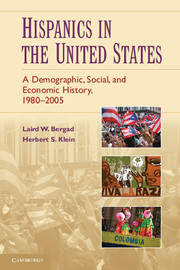Book contents
- Frontmatter
- Contents
- List of Graphs, Tables, and Maps
- Introduction
- 1 Immigration to the United States to 1980
- 2 The Hispanic Population to 1980
- 3 Population Growth and Dispersion, 1980–2005
- 4 The Demography of the Hispanic Population
- 5 Wealth and Poverty
- 6 Educational Attainment
- 7 Citizenship, the Latino Electorate, and Voter Participation
- 8 Occupational Structures, Employment, and Unemployment
- 9 English Language Abilities and Domestic Usage
- 10 Hispanic Business Ownership
- 11 Race
- 12 Endogamous and Exogamous Marriage Patterns among Latino Household Heads
- 13 Conclusion
- Bibliography
- Index
13 - Conclusion
Published online by Cambridge University Press: 05 June 2012
- Frontmatter
- Contents
- List of Graphs, Tables, and Maps
- Introduction
- 1 Immigration to the United States to 1980
- 2 The Hispanic Population to 1980
- 3 Population Growth and Dispersion, 1980–2005
- 4 The Demography of the Hispanic Population
- 5 Wealth and Poverty
- 6 Educational Attainment
- 7 Citizenship, the Latino Electorate, and Voter Participation
- 8 Occupational Structures, Employment, and Unemployment
- 9 English Language Abilities and Domestic Usage
- 10 Hispanic Business Ownership
- 11 Race
- 12 Endogamous and Exogamous Marriage Patterns among Latino Household Heads
- 13 Conclusion
- Bibliography
- Index
Summary
The presidential election of 2008 and the confirmation of Judge Sonia Sotomayor as the first Hispanic justice of the U.S. Supreme Court in 2009 have highlighted the extraordinary, and growing, political clout of the Latino population in the United States. It may be argued that President Barack Obama's electoral victory in at least four swing states in November 2008 – Florida, New Mexico, Colorado, and Nevada – was closely linked to the overwhelming support he received from Hispanic voters in each of these states. Latinos, along with African Americans, have struggled to secure civil rights and end institutionalized and less-formal forms of discrimination for decades. Shear demographics, however, have placed Latinos front and center as a political and economic force of extraordinary importance that must be reckoned with today and certainly in the future.
In July 2008 the Census Bureau estimated that Latinos numbered approximately 47 million persons, about 15.4% of the total U.S. population. It has been projected that by 2050 this population will triple in absolute size and will comprise 30% of the population of the United States. Latinos have been as mobile as the rest of the U.S. population and have migrated from the traditional southwestern and western states to areas of the nation where there have never been many Latinos, such as the Southern and Southeastern states. Latino demographic projections have politicians and marketing professionals in the private sector in a state of near frenzy. Not only did the Hispanic vote help elect President Obama, but the Democratic Party succeeded in reversing the trend in Hispanic voting patterns toward the Republican Party, which had been evident in the 2000 and 2004 presidential elections. This growing political importance on the national stage was accomplished despite the fact that Hispanics continued to have the lowest political participation rate of the major racial/ethnic groups in the United States. In November 2008 only half of all Latino citizens 18 years of age and older voted compared with about two-thirds of non-Hispanic whites and blacks. However, the Hispanic vote doubled in its portion of the total U.S. electorate that voted from 3.6% in the 1988 presidential elections to 7.4% in 2008. It is certain that the Latino political participation rate will increase in the future, and as the Hispanic population continues to expand, the percentage of total voters who are Latinos may lead to a veritable upheaval in the U.S. political system.
- Type
- Chapter
- Information
- Hispanics in the United StatesA Demographic, Social, and Economic History, 1980–2005, pp. 406 - 418Publisher: Cambridge University PressPrint publication year: 2010



